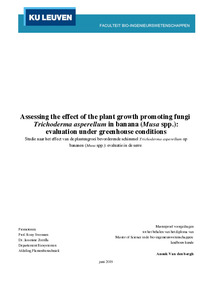| dc.contributor.author | Van den Bergh, A. |
| dc.date.accessioned | 2022-10-05T14:57:16Z |
| dc.date.available | 2022-10-05T14:57:16Z |
| dc.date.issued | 2019-06 |
| dc.identifier.citation | Van den Bergh, A. (2019). Assessing the effect of the plant growth promoting fungi Trichoderma asperellum in banana (Musa spp.): evaluation under greenhouse conditions. Leuven, Belgium: Katholieke Universiteit Leuven, (132 p.). |
| dc.identifier.uri | https://hdl.handle.net/20.500.12478/7845 |
| dc.description.abstract | Bananas (Musa spp.) are one of the most important crops in the global food crop industry, the second most important fruit crop and an important staple crop around the world. Due to the increased trend in global population, a raise in the intensity in crop productivity is needed. The use of plant growth-promoting microorganisms (PGPM) could be an alternative to improve the
stress-tolerance and productivity of crops, thus, reducing the amount of chemical pesticides and fertilizers needed. Trichoderma spp. are common PGPM found in the rhizosphere of plants. They can increase plant growth and resistance against (a)biotic stresses. In this thesis, the effect of the soil fungus T. asperellum on the growth of banana plants under greenhouse conditions
was evaluated. The first objective of this study was to examine if T. asperellum induces growth of the pseudostem, leaves and/or root system of banana plants. Therefore, two different experiments were carried out. In the first one, the effect of the strain TRC900 of T. asperellum on the growth in liquid medium of two banana genotypes, ‘Gran Enano’ and ‘Yangambi km5’, was evaluated 21 days post inoculation (dpi). No significant increase in growth parameters was noticed between control and inoculated plants, possibly due to too limited space between plants. In the second experiment, the growth of ‘Valery’ plants was evaluated at 9 and 15 weeks after planting (WAP) and first inoculation. Here, two different T. asperellum strains (TRC900 and T34) were
compared vs. a control treatment. At 9 WAP, most of the parameters showed a significant increase in both treatments with T. asperellum strains. However, at 15 WAP, the parameters generally showed less or no significant difference between the inoculated and control plants. This suggests that the growth rate of the plants treated with a T. asperellum strain was slowing down, most probably due to the size limitation of the pots, causing the control plants to catch up with them. Secondly, the influence of T. asperellum on the global expression of nine gene families was examined. Therefore, a RT-qPCR analysis was carried out on root samples in two different experiments in order to compare gene expression patterns at an earlier and later stage of the
Trichoderma-root colonization process. In the first experiment, the samples were taken from ‘Gran Enano’ and ‘Yangambi km5’ plants, grown in liquid medium, 24 and 48 hours post inoculation (hpi). In the second experiment, ‘Williams’ plants were grown in pots 18 WAP and first inoculation. Genes related to fermentation, anaerobic respiration, and ethylene production showed significant upregulation in plants treated with Trichoderma either at 24 hpi, 48 hpi or 18 WAP. On the other hand, the gene related to the antioxidant machinery, was only upregulated at early stages of the colonization process, indicating higher stress levels in roots at those time points (24 and 48 hpi). |
| dc.format.extent | 132p. |
| dc.language.iso | en |
| dc.publisher | Katholieke Universiteit Leuven |
| dc.subject | Bananas |
| dc.subject | Food Crops |
| dc.subject | Musa |
| dc.subject | Plant Diseases |
| dc.subject | Abiotic Stress |
| dc.subject | Pesticides |
| dc.subject | Fertilizers |
| dc.subject | Growth |
| dc.subject | Genotypes |
| dc.subject | Gene Expression |
| dc.title | Assessing the effect of the plant growth promoting fungi Trichoderma asperellum in banana (Musa spp.): evaluation under greenhouse conditions |
| dc.type | Thesis |
| cg.contributor.affiliation | Katholieke Universiteit, Leuven |
| cg.contributor.affiliation | International Institute of Tropical Agriculture |
| cg.identifier.bibtexciteid | VANDENBERGH:2019 |
| cg.authorship.types | CGIAR and advanced research institute |
| cg.iitasubject | Agronomy |
| cg.iitasubject | Banana |
| cg.iitasubject | Plant Breeding |
| cg.iitasubject | Plant Production |
| cg.notes | IITA supervisor: Prof. Rony Swennen |
| cg.publicationplace | Leuven, Belgium |
| cg.accessibilitystatus | Limited Access |
| cg.reviewstatus | Internal Review |
| cg.usagerightslicense | Copyrighted; all rights reserved |
| cg.targetaudience | Scientists |
| cg.futureupdate.required | No |
| cg.contributor.acknowledgements | Firstly, I would like to thank Prof. Dr. Ir. Rony Swennen and Dr. Jassmine Zorrilla for proposing this interesting topic and giving me the opportunity to work both in the greenhouse and the laboratory. Your help and advise was very much appreciated, as well as all the time you spend on correcting the thesis. I am also very grateful to Jassmine for helping me with the statistical analysis, explaining me how to work with the program Statistica, your support and so much more. I would also like to thank Dr. Ir. Lieselot Van der Veken for her advise in the greenhouse. Next, I am grateful to all the members of the Laboratory of Tropical Crop Improvement, especially Hien, without whom I would be lost in the laboratory and greenhouse. Your expertise, advise and guidance has been very useful. Further, I really appreciate the help of Els, Kaat and Hendrik for helping me in the greenhouse whenever the workload was too much and Jelle for aiding me with some computer programs. I would also like to thank my fellow thesis student Janne for assisting me in the greenhouse. Finally, I want to thank my family and friends for their mental support. |

